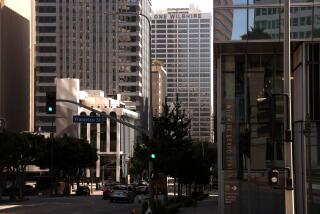Dot-coms want the beach in their address
Compared with most of the region’s white-collar office market, the less corporate environs of Santa Monica and Venice are looking sharp.
Technology and entertainment companies that long ago mastered the knack of making money without dressing up are now paying top dollar to rent space in some of Southern California’s most desirable neighborhoods.
The office vacancy rate in downtown Santa Monica is a mere 4%, a fraction of the county average, said real estate broker Craig Kish of Jones Lang LaSalle. While most parts of Los Angeles County have seen occupancy fall and flatten, Santa Monica is enjoying a V-shaped recovery.
“A lot of companies we are meeting with are doubling or tripling in size,” Kish said.
Young Internet-based businesses such as TrueCar, Riot Games and BeachMint have been expanding their workforces and their offices. Often the founders are Web veterans who see value in being in a coastal hot spot where California cultural stereotypes actually hold true.
The laid-back beach scene combined with Santa Monica’s sophisticated restaurant and shopping options are a potent lure for computer whizzes and creative types.
“These folks want to live a certain lifestyle,” said broker Matthew Brainard of real estate firm Studley. “They work crazy hours, so they might want to surf in the morning, ride a bike to work and enjoy everything they can then and there.”
Santa Monica was a tech industry outpost for the same reasons in the great boom of the late 1990s. That boom ended badly, of course, but the flag had been planted. Defunct dot-coms left behind converted industrial buildings and other so-called creative offices ripe for the revival now underway.
“A lot of us in tech call it Silicon Beach,” said Josh Berman, chief executive of BeachMint, an operator of websites for products designed by celebrities. “There are a lot of great companies here. You feel a sense of community.”
The tech cluster is big enough now to be self-perpetuating, industry observers said. Internet companies and related enterprises such as entertainment and advertising firms that work in digital media want to be near one another for business and social reasons. Togetherness abets recruiting and networking.
“Smart technologists want to work with other smart technologists,” said Steve Hansen, president of auto information website TrueCar. “There is a common lexicon, a common culture that begins to emerge.”
Hansen had an office near the beach on Main Street in 1997 when he was an officer of Web hosting service GeoCities. The neighborhood didn’t feel safe.
“We escorted female employees to the parking lot” at night, he said. “It’s been amazing to watch how gentrified this place has become. It’s heartening to see a really positive, radical transformation.”
Today, TrueCar provides beach cruiser bicycles for employees to travel between its offices on Broadway and in the Clock Tower, a 12-story 1920s office building that has emerged as one of the choicest addresses for creative types.
Some tenants in the Art Deco edifice pay as much as $6 a square foot per month, easily twice the rate for offices in the best skyscrapers in downtown Los Angeles. Occupants include online deal-of-the-day company LivingSocial, Advertising.com and post-production company Famiglia Di Vendetta.
To be sure, Santa Monica is not just for techies and entertainment folks.
Traditional law firms, accountants and other mainstream professionals have long called it home. But large complexes that were built in the 1980s and ‘90s to accommodate them, such as the Water Garden and Yahoo Center (once known as Colorado Place), are being overrun by tech and showbiz companies.
The Binoculars Building, a famous office complex in nearby Venice built in 1991 for an advertising agency, has been taken over by Google.
Expansion often comes at a cost. New companies may start out in small converted industrial buildings with polished concrete floors and exposed ductwork, but they often discover, unhappily, that they must rent more corporate-looking space in large buildings as they grow.
Creative workers “feel constrained” in such standard offices, TrueCar’s Hansen said. “One of the things that defines a successful tech company is the company culture. Tech people tend to be fairly nonlinear.” Not all firms that fit that profile can afford to be in Santa Monica or want to pay its high rents. Neighboring markets also benefiting from the tech-entertainment boom include Playa Vista, El Segundo, West Los Angeles and Culver City, which has lower rents and taxes.
“I can’t figure out why companies don’t go to Culver City,” broker Kish said. “It must be the allure of being close to the beach.”
Southern California’s tech industry is growing robustly and is, by some estimates, the second-largest in the country, but it still lags far behind Silicon Valley and other parts of the Bay Area, brokers said. Businesses are growing there too, but the dot-com meltdown of a decade ago left millions of investors and many office landlords holding the bag.
The tech industry is less speculative now, with some successful entrepreneurs starting their second or third companies in Southern California, said venture capitalist Nate Redmond of Rustic Canyon Partners, a Santa Monica firm that invests in Internet-related businesses.
“Over the last 18 to 24 months we have seen a dramatic surge in company formation and in the overall entrepreneurial ecosystem here in L.A.,” Redmond said. “I think Santa Monica will be at the heart and it will extend into Culver City and Venice.”
There is debate among investors on just how financially viable the new tech boom is, he said, but this time around the audience and potential customer base is much larger and their access to the Web is dramatically faster.
“In 1999, we had 50 million dial-up users,” Redmond said. “Now we have 2 billion broadband users.”
More to Read
Inside the business of entertainment
The Wide Shot brings you news, analysis and insights on everything from streaming wars to production — and what it all means for the future.
You may occasionally receive promotional content from the Los Angeles Times.











